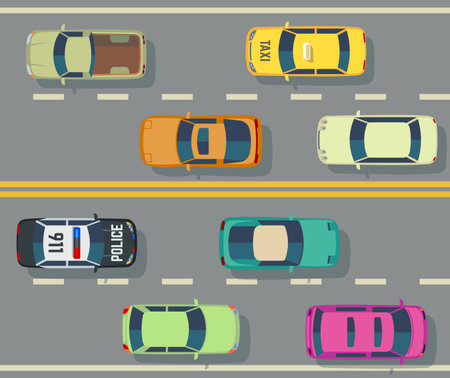1. Check Your Car’s Fluids and Battery
Before hitting the road, make sure all essential fluids in your car are at the proper levels. These fluids keep your vehicle running smoothly and help prevent breakdowns during your trip.
Essential Fluids to Check
Here are the key fluids you need to inspect before a long drive:
| Fluid | Purpose | How to Check |
|---|---|---|
| Engine Oil | Lubricates engine parts and reduces friction | Use the dipstick; the oil level should be between the minimum and maximum marks |
| Coolant | Regulates engine temperature and prevents overheating | Check the coolant reservoir and make sure the level is between the “min” and “max” lines |
| Brake Fluid | Enables proper brake function | Inspect the brake fluid reservoir; the fluid should be clear and at the recommended level |
| Transmission Fluid | Helps with smooth gear shifting | Check the dipstick while the engine is running; the fluid should be at the correct level and clean |
| Windshield Washer Fluid | Keeps your windshield clean for better visibility | Refill if low; make sure it’s suitable for all weather conditions |
Testing Your Car Battery
A dead battery can leave you stranded miles away from help. To prevent this, check your battery before your road trip:
Steps to Check Your Battery
- Look for signs of corrosion on the battery terminals and clean them if necessary.
- Use a multimeter to check the voltage; a fully charged battery should read around 12.6 volts when the car is off and 13.7-14.7 volts when running.
- If your battery is more than three years old, consider having it tested at an auto shop or replacing it if needed.
By ensuring your fluids are at the right levels and your battery is in good condition, you’re taking an important step in preventing unexpected issues on your journey.
2. Inspect Tires and Brakes
Your tires and brakes are crucial for a safe and smooth road trip. Before hitting the road, take the time to check them thoroughly.
Check Tire Pressure
Proper tire pressure ensures better fuel efficiency, a smoother ride, and better handling. Use a tire pressure gauge to check each tire and compare it to the manufacturer’s recommended PSI, which you can find in your owner’s manual or on a sticker inside the driver’s door.
Examine Tread Depth
Worn-out tires can reduce traction and increase the risk of accidents, especially on wet roads. You can check your tire tread depth using a penny:
| Penny Test | Result |
|---|---|
| Insert a penny into the tread with Lincolns head facing down. | If you can see the top of Lincoln’s head, your tread is too low, and you should replace your tires. |
| If part of Lincoln’s head is covered by the tread, your tires are still in good condition. | You can continue using them but keep monitoring regularly. |
Look for Visible Damage
Check for cracks, bulges, or embedded objects like nails in your tires. If you notice any issues, it’s best to get them repaired or replaced before your trip.
Verify Brake Condition
Brakes are essential for your safety, especially on long trips that require frequent stopping. Signs of brake issues include:
- Squeaking or grinding noises
- A soft or spongy brake pedal
- Vibrations when braking
- A burning smell while driving
If you notice any of these signs, have a mechanic inspect and replace your brake pads or rotors if necessary. Good brakes ensure shorter stopping distances and better control on the road.

3. Test Lights, Wipers, and HVAC System
Before hitting the road, its essential to check your cars lights, windshield wipers, and climate control system. These components contribute to your safety and comfort during a long-distance drive.
Check All Exterior and Interior Lights
Ensure that all your vehicles lights are functioning properly, including:
| Light Type | What to Check |
|---|---|
| Headlights | Make sure both high beams and low beams work. |
| Brake Lights | Press the brake pedal and have someone confirm they illuminate. |
| Turn Signals | Test each turn signal to ensure proper blinking. |
| Reverse Lights | Put the car in reverse (with the engine off) to check. |
| Interior Lights | Test dashboard lights, dome lights, and any other interior illumination. |
If any bulbs are out, replace them before your trip to avoid potential visibility or safety issues.
Inspect Windshield Wipers and Wiper Fluid
Good visibility is crucial when driving long distances. Check your windshield wipers for any signs of wear and tear, such as:
- Streaking or smearing
- Skipping or making noise
- Cracks or peeling rubber
If your wipers are worn out, replace them to ensure a clear view in case of rain or debris. Also, top off your wiper fluid to clean your windshield whenever necessary.
Verify the Heating and A/C System
Having a properly working heating and air conditioning (A/C) system ensures a comfortable drive regardless of weather conditions. Test your HVAC system by:
- Turning on the heat to confirm warm air circulates.
- Switching to A/C mode to check if it cools properly.
- Testing different fan speeds and vent settings.
If the system isnt working effectively, have it serviced before your trip so you can drive comfortably in any climate.
Final Check
After verifying lights, wipers, and your HVAC system, youre one step closer to a smooth road trip. Proper visibility and climate control can make all the difference during your journey.
4. Pack an Emergency Kit
When youre heading out on a long-distance road trip, being prepared for unexpected situations is essential. Packing an emergency kit ensures you have the necessities to handle minor issues without feeling stranded. Here are some must-have items for your emergency kit:
| Item | Purpose |
|---|---|
| First Aid Kit | To treat minor cuts, scrapes, and medical emergencies. |
| Jumper Cables | To jump-start your car if the battery dies. |
| Flashlight & Extra Batteries | For visibility in case of nighttime breakdowns. |
| Tire Repair Kit | To temporarily fix a flat tire. |
| Water & Snacks | To stay hydrated and keep energy levels up. |
| Basic Tools | To handle minor car repairs on the road. |
Having these essentials in your vehicle can make a big difference in how you handle unexpected roadside issues. Keep your emergency kit in an easily accessible spot, such as the trunk or under a seat, so you can grab it whenever needed. While you hope to never use it, being prepared ensures a safer and smoother road trip experience.
5. Five. Plan Your Route and Fuel Stops
Before hitting the road, take some time to map out your route. Planning ahead can save you from unnecessary delays, last-minute stress, or even running out of gas in the middle of nowhere. A well-thought-out route ensures a smoother, more enjoyable trip.
Use Navigation Apps to Stay Updated
Navigation apps like Google Maps or Waze can help you find the best routes, avoid traffic jams, and even suggest alternate roads in case of road closures. These apps also provide real-time updates on traffic conditions, letting you adjust your journey as needed.
Mark Gas Stations and Rest Stops
Long stretches of highway can mean fewer gas stations, so its best to identify fuel stops along your route. Running low on gas in a remote area is never a good situation. Similarly, knowing where rest stops are located ensures you have safe places to take breaks, grab snacks, or switch drivers if needed.
Suggested Route Planning Checklist
| Task | Why Its Important |
|---|---|
| Plan your main route and backup routes | Gives you the flexibility to avoid delays |
| Locate gas stations along the way | Prevents running out of fuel in isolated areas |
| Mark rest stops or dining areas | Ensures comfortable breaks and avoids fatigue |
| Check for construction zones or road closures | Helps avoid unexpected detours and delays |
Prepare for Unexpected Changes
Even with a well-planned route, things can change. Weather conditions, accidents, or roadwork might require last-minute detours. Be flexible and keep an alternate plan in mind. Having a paper map as a backup could also be useful in case of limited cell service.

